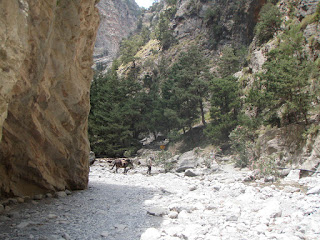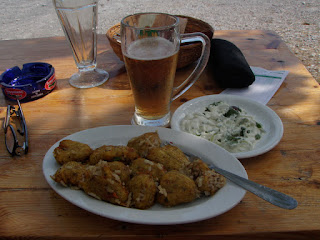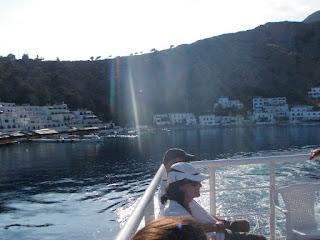Fountains are scattered all over Crete
After, exploring the nature in Samaria Gorge and the history in Chania, here I am on my way to
Argiroupoli, one of the most recommended villages to dive into Cretan country
culture and authentic Greek food. As I drive up and around the mountains that will finally allow me reach my destination, I am still thinking of my new friend Costas, who
took me to the airport before I left Athens last week. Little did I know then
that he would turn out to be a very wise and intelligent man in terms of his
understanding of human condition, politics in the world and Greek existence.
Argyroupoli from a distance
Since I knew I would return to Athens this week for one day to
attend the annual Fulbright celebration at the American embassy, I had asked
him before my first departure from Athens, whether he would be interested in
driving me around through the 24 hours I would be in Athens. He delightedly
accepted. I was already aware that his knowledge of Greek language was not bad
at all. Whatever linguistic questions I asked him, he would come up with an
answer and when he couldn’t, his limitation was more related to how to explain
it to me in English not that he didn’t have the answer in Greek. That is the
kind of man I respect to the greatest extent. Humility with his strengths and
insight to his weaknesses; this is the key to healthy connection with one
another, isn’t it? Had every man had these two qualities, wars would have been
very difficult to breed…
The reception at the
American Embassy was lovely, acknowledging the success of the current and
future awardees as well as targeting the attending funders for more support for
the Greek Fulbright activities. I was very impressed with the Greek Fulbright
Foundation’s activities!! I learned, first and foremost that Fulbright is the
largest exchange organization in the world. The US State Department supports
the international travel costs of trainees and scholars and provides minimal
stipend for livelihood of the awardees in whichever country they are matched
with. However, the costs of domestic travel and accommodation belong to the
hosting country’s Fulbright organization, which requires constant fund-raising.
Beautiful doors and windows are all around Argyroupoli, too
Thus, it was partly Greek Fulbright’s success that they have hosted 34 American
Fulbright awardees this year and will be sending out 35 Greeks to the USA for
various lengths of time anywhere from one semester to 2 years this summer.
Another very unique characteristic was that more than half the Greek awardees
were accepted to programs such as jazz, classical music, art history, film
making, etc totally different than many other countries, which usually go after
projects related to almost exclusively business. After all, this is the land
that gave birth to many forms of art, philosophy, and democracy among other
intellectual creations of mankind. I was proud of these young people.
Costas sends a friend
of his to take me to the Embassy from my hotel. A very talkative man, Ianni. He
wants to practice his English, I, my Greek, he gets it. We start chatting in
Greek, but soon we slip into English since his English is much better than my
Greek. The trigger for this is an interesting conversation that breaks out once
I tell him that my grandparents were part of the catastrophe as Greeks call it when
they were sent to Asia Minor when Greeks in Anatolia were sent to Greece. He
tells me that was in 1922 as everybody else reports, but I know that my people
went to Turkey in 1913.
Fig tree growing inside an ancient ruin
He corrects me that they cannot be part of catastrophe
since the Greeks in Turkey were the victims of catastrophe, which took place in
1922. All of a sudden it is clearer in my mind: In 1922, the make-shift Turkish
army of Ataturk had swept out of the Western part of Turkey, the invading Greek
army supported by the British and at least some of the Greek population living
in Turkey. The local Greeks were lured to the illusion that the Brits could help
the native Greeks and the mainland Greek army bring the Byzantine grandeur back
to them, which led to a true catastrophe! In official Turkish history, it was
taught for over a century that the Greeks were “spilled into the Aegean” and
had to be rescued by the British ships in Izmir Bay. The Turkish side reports
the departing Greeks had set fire to downtown Izmir not to leave their
belongings to Turks. The Greek side claims the Turkish army had set the city on
fire to force the Greeks to leave. The only place the Greeks could go was the
water, where they found refuge in British ships waiting on stand-by in Izmir
Harbor. I doubt all the historical facts of that event have been released even
after almost a century.
Roadside shrines come in all shapes and embellishment
Ianni defends that
the muslims in Greece didn’t experience any hardship because of the events of
that time, it was the Greeks that suffered. Hmmm, we are in a delicate place
right now, it is impossible for me, being from Turkey, to convince him that
both sides must have suffered and it was very unfortunate that both shores of
the water, the Aegean have been cleansed from the rich cultural elements of the
past just because of religion, which had never been a problem either in Greece
or in Anatolia until the British sewed hatred seeds in communities against one
another harvested by immense amounts of fear. He jumps into questioning why
can’t Christians practice their religion in Agia Sofia in Constantinopolis? I
try to get him to see that it is unfortunate that both churches in Turkey and
mosques in Greece are basically empty. He is all about victimization of Greeks
throughout the history. “And now nobody likes us. Macedonians want Scopia,
Turks want the 12-Islands and Thrace. Look what Europe is doing to us. They all
want us to disappear and we will. Soon there will be no Greece!”
I feel for him but my
comments on “Greek history and nation are so strong it is impossible to destroy
Greece, don’t worry.” Bounce back as if he hasn’t heard a word of it. One last
attempt from him is “They want to take away Scopia from us. People who live
there are Greeks, they are not Macedonians!” I almost laugh deep inside: He
could be one of the extreme right wing guys I saw at the Gold Dawn
demonstration two weeks ago in Athens. Furthermore, his rhetoric is so similar
to the official Turkish position on Kurdish people until a decade ago “Kurds
are actually mountain Turks and they speak a dialect of Turkish, but they don’t
know it!” I remember dear Manolis telling me during one of our lunch time
discussions “Good thing, there is no minority to mention in Greece, Greek
governments would have committed genocide without blinking their eyes”. I hope
this is not true.
When I share with
Costas that I was appalled with Ianni’s nationalist streak, Costas’ beauty
comes out. He tells me almost exactly what I have been thinking about current
Greek and Turkish national identities all along. He states that some lunatics
in Greece want to bring back the past, they want Constantinople back, and they
are in a total victimization mode. I share with him that it is so similar to
current nationalistic Turkish identity that is a clash between the imperialist
grandeur of the past and the relative unimportance of today. He gets it, his
body language tells me that this is his exact sentiment.
One of the several churches in Argyroupoli
We agree that we, on
both sides of the water, need to have an open mind and see that there is
nothing we need to fight about. In fact, what would Turkish government do if it
had the right to govern the 12-islands: install a few mosques on each island
just as the Greek government would reconvert Aigia Sofia into a church and open
up many additional churches, perhaps convert most of the mosques to churches as
well. Otherwise, the food would remain the same, the music, the dances, the expression
of self and community would remain the same. We wish everybody could see all
the fight in fact is over which religion will dominate. With these thoughts
and partly due to poor signage, despite my GPS, I miss my turn several times,
but eventually make it to the beautiful village of Argyroupoli. As I usually
do, I avoid following the crowds and park my car at the entrance of the lower
town and start climbing toward the upper town center. First person I bump into
turns out to be a retired Norwegian ophthalmologist, who lives part of the year
in this lovely village in a house that is being renovated.
Tavern Ancient Lappa
We talk a bit about
my work and she gets excited about discussing it with her pediatrician friends
in Rethymno. Go figure, small world! I ask her about tavernas that are not
frequented by tourists that much. She guides me to ArhiaiLappa named after the
ancient city of Lappa, on top of the ruins of which this village is built. As I
walk toward the tavern, I see many examples of how the ancient city actually is
incorporated into the new village. Some buildings are falling apart, but nobody
can touch them other than the government due to archeological site status, some
ancient walls make up one side of a contemporary building, on and on… Finally I find a
tavern on cross roads and meet a sweet sweet Greek woman named Constantinidi,
short D, for tourists I guess. I order a Greek coffee as usual. As she serves
other guests, she stops by and we chat in bits and pieces.
As soon as she hears
my grandparents are from Chania, she exclaims like an innocent child awarded
the long awaited toy “Bravo!” as if I had a choice in it. What is it that even
the best of us feels closer to a person when we discover s/he is one of us? Our
implicit memories? Our suppressed othering of those not one of us? Knowing
without knowing what a person holds if our roots are entangled with one another
even in a distant distant past? What is a soul mate? Our mirror image? Someone
that thinks, speaks, behaves, and feels more or less like ourselves? Or can
soul mates complement and enrich one another with their differences as well as
shared values? I still like her, innocence is all over her.
Another door window set from Argyroupoli
She guides me to
all the places I should see in the village not knowing I will bump into a
volunteer guide! I want to take a picture of her, she is delighted, but she
prefers a picture of the two of us. A German tourist is more than happy to
help. I give her my card and ask her to write to me so I can send her the
picture. She is delighted even more. When I ask to pay, she tells me “It is on
me, you come back for lunch”. I leave the payment as tip with an “Efharisto
para para poli”. On my way up, I take
a side street and greet a man sitting under an umbrella with my usual “Kali
mera”. He responds joyfully and we start a chat. His name is Manolis and he
tells me he would be happy to show me old Venetian and Roman ruins.
Manolis and an ancient (?) amphora he has on display...
He is
pointing to the narrow alley that goes down to the ravine. I am a bit
skeptical, thinking of all the rape stories from the western world… Something
inside me says “Give him an innocent chance, perhaps he is after a few euros,
who knows.” The urban brainwashing in me
tells me to keep my distance with him, though. Put him ahead of me, stay a yard
behind him, and when he touches my arm in a friendly way at times, pull my arm
and cut the contact right away. Part of me feels bad for being polite and
respectful but somewhat distant to him, but my cortex tells me “better safe
than sorry”. First thing he does is to give me a blossom from one of the vines
in his yard. That is when I notice a freebag dangling over one of his
shoulders, now it is clear that this is a businessman here. Opening whatever is
in his backyard that he cannot touch to tourists! He gets it, he respects my
personal space except for one time when I almost tumble over a Venetian marble
block. At some point, he stops and picks for me two handfuls of purple little
plumbs. Despite my polite protests, he insists that I take it and don’t feel
shy about it. What can I do except for devouring the most delicious plumbs
handed to me.
He shows me Venetian
archways, Roman columns, Venetian untouchable buildings still standing upright,
entrance to an underground “fortezza”. I understand only half of what he says,
he decided I knew Greek and is bombarding me with information. Who knows if he
is telling me the truth, but I scold myself “Trust him Resmiye and just resolve
that you hired a guide and a lovely one at that, who has only a handful of
teeth, but a sweet smile and who won’t harm you. At some point I ask him “Do
you live here?” and regret the question right away. I don’t want him to think I
want to go to his house! He says “Here” pointing to a door, I instantaneously
stay behind one more time. He brings out a very old camera on foot, shows me
how it works and takes a picture of me with the camera. Then he invites me
inside, I just peek through the door when he is inside, it is a tiny little
shack with all kinds of odds and ends, all over. He pours a shot of raki for
me, which I have to refuse, then offers me a cookie with sesame seeds. Although
I can’t eat that, either, I take it not to offend him.
He is not surprised
when I give him his well-deserved tip. This reminds me of the conversation
Costas and I had this morning one more time. It is Costas’ position that Greeks
that migrated to America were regarded as “taking what didn’t belong to them
very easily”. He even goes too far to say they were known as kleftis, for which
one could go to jail. I take it as thieves/stealing. My position on the other
hand is that Greeks in Turkey were known as being successful businessmen. I
interpret what Manolis did this afternoon as turning a situation that I started
by conversing with him into a business opportunity for himself without forcing
me into anything. I wonder how Costas would have interpreted this.
I go to the town
center and buy some gifts for my friends in the USA from a lovely young Greek
woman. She also has decayed teeth. What happened to the good Greek health care,
is it decaying under the austerity measures, too? I share with her my experience with Manolis
and my curious skepticism, we get a good laugh out of it. She tells me he is a
good man, but just does this thing with tourists. I tell her to tell Manolis
that I had a great time and thank him one more time for me. I am sure they will
share it with the entire village for a while, and sure enough, the moment I
walk out of her store, she is sharing what I told her with the store owner
across hers!
As I am looking for
the springs, I come across the cemetery and the old church in it on a hill
that dominates the entire valley. It is interesting that all Orthodox
cemeteries that I visited both in Turkey and Greece happen to be on top of
hills that has a panoramic view. I wonder if they feel the dead deserves space
and being closer to the sky than the living. Had I known, the springs would
have turned out to be merely a tourist trap, I would have spent more time in
the cemetery with the peace of the dead, savoring the mountains all around us
diving into deep valleys under the warm breeze filling my lungs with delicious
scents of sage, thyme, and who knows what else that grows in this fertile land…
 |
| Series of villages scattered between Argyroupoli and Rethymno |





























































